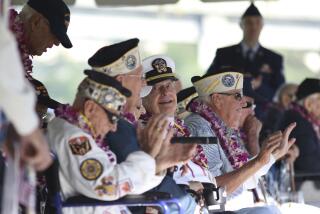L. Maitland; First to Fly to Hawaii
- Share via
The retired Air Force general who was the first pilot to fly from the U.S. mainland to Hawaii 63 years ago and then--after seeing a nuclear weapons explosion--gave up his military career for the ministry, died March 27 in an Arizona rest home.
Lester J. Maitland, who earned the Distinguished Flying Cross for his pioneer flight, was 91 and had been living in Red Bluff, Calif., before his failing health forced him to the Scottsdale home where he was near family members.
His granddaughter, Leslie Stohlgren, said he died of the complications of age.
As an Army lieutenant and pilot, Maitland and co-pilot/navigator Albert F. Hegenberger flew a three-engine Fokker called the “Bird of Paradise” from Oakland to Wheeler Field on Oahu in June, 1927.
The 2,400-mile flight took 25 hours, 49 minutes and 30 seconds. Their navigation was aided by a radio beacon set up by the Army on the island. It worked only intermittently, however, and they navigated primarily by the stars.
The only thing that marred the trip, they later said, was that they never did locate the chicken, soup and chocolate that had been placed aboard and went without food for a day.
“The big thing about that feat was to find the island. It didn’t allow for any mistakes. They didn’t have the (navigational) equipment they have today,” said Tad Hankey, an old friend and military colleague of Maitland.
Both airmen received the Distinguished Flying Cross. They were celebrated at a huge reception in Honolulu and on their return in San Francisco.
Hegenberger died in 1983 in retirement in a Florida city named, coincidentally, Maitland.
A native of Milwaukee, Maitland had joined the old Army Air Corps in 1917. Hankey said Maitland was the first pilot to hit the 200-m.p.h. mark and received a congratulatory letter from Orville Wright. During his military career he was an aide to Gen. Billy Mitchell.
At the outbreak of U.S. involvement in World War II, Maitland was commanding officer of Clark Field in the Philippines when it was bombed by Japanese planes and fell. He left the islands with Gen. Douglas MacArthur but asked to be assigned immediately to a combat bomber group.
Maitland became commanding officer of the 386th Bomber Group in Europe, where Hankey was his operations officer. The group, flying Martin B-26 bombers, was cited as the outstanding medium bomber group in the European theater, Hankey said.
After the war he became director of aeronautics in Wisconsin in 1949, and then took a similar state position in Michigan from 1950 to 1956.
After seeing an atom bomb test in the Nevada desert shortly after the war, Maitland resigned as a brigadier general and in 1956 was ordained an Episcopal minister in Iron River, Mich.
He said when he resigned that “all my life I have served Mammon and now I want to serve God.”
He retired to Red Bluff several years ago and a memorial service will be held there for him today. He is survived by his wife, Kathleeen, a daughter, five grandchildren, three great-grandchildren and two great-great grandchildren.
More to Read
Sign up for Essential California
The most important California stories and recommendations in your inbox every morning.
You may occasionally receive promotional content from the Los Angeles Times.













